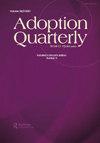有国际收养儿童的家庭和有2岁亲生儿童的家庭中的母子互动:异同
IF 0.6
Q3 SOCIAL WORK
引用次数: 1
摘要
摘要对收养和生物学二人组母子互动的录像观察显示,2岁时互动的整体质量存在一些显著差异。差异包括母亲和孩子在自由游戏和教学环境中观察到的行为。养母和生母对孩子的敏感性/反应性没有显著差异,这对孩子有利的社会和情感发展很重要。考虑到收养家庭中母子互动的建立较晚,以及儿童的不良选择前经历,这一结果必须被认为是非常有利的。然而,母亲和孩子的行为都存在显著差异。与亲生母亲相比,养母在这两种环境中都对孩子表现出较少的积极尊重,在自由游戏环境中表现出更多的侵扰行为。此外,与亲生儿童相比,被收养的儿童在这两种环境中表现出较少的积极情绪和母亲的参与,在教学环境中的持续关注程度也较低。值得注意的是,孩子被收养时的年龄与母亲或孩子在互动任务中观察到的行为无关。本文章由计算机程序翻译,如有差异,请以英文原文为准。
Mother–Child Interaction in Families With Internationally Adopted Children and Families With Biological Children at Age 2: Similarities and Differences
Abstract Videotaped observations of mother–child interactions in adoptive and biological dyads showed some significant differences in overall quality of interactions at age 2. The differences included both mother and child observed behavior during a free-play and teaching setting. There were no significant differences in adoptive and biological mother’s sensitivity/responsiveness toward their children, which has been documented to be important for children’s favorable social and emotional development. Taking into consideration the late establishment of mother–child interaction in adoptive families and the children’s adverse preadoption experiences, this result must be considered quite propitious. However, there were significant differences in both mother’s and children’s behavior. Adoptive mothers expressed less positive regard for their children in both settings and displayed more intrusive behavior in the free-play setting compared to biological mothers. Furthermore, adopted children showed less positive mood and engagement of their mothers in both settings and lower degree of sustained attention in the teaching setting than the biological children. Notably, the children’s age at adoption was not connected to either mothers’ or children’s observed behavior during the interaction tasks.
求助全文
通过发布文献求助,成功后即可免费获取论文全文。
去求助
来源期刊

Adoption Quarterly
SOCIAL WORK-
CiteScore
1.60
自引率
12.50%
发文量
3
期刊介绍:
Adoption Quarterly is an unparalleled forum for examining the issues of child care, of adoption as viewed from a lifespan perspective, and of the psychological and social meanings of the word "family." This international, multidisciplinary journal features conceptual and empirical work, commentaries, and book reviews from the fields of the social sciences, humanities, biological sciences, law, and social policy. In addition to examining ethical, biological, financial, social and psychological adoption issues, Adoption Quarterly addresses continuity in adoption issues that are important to both practitioners and researchers, such as: negotiation of birth and adoptive family contact.
 求助内容:
求助内容: 应助结果提醒方式:
应助结果提醒方式:


